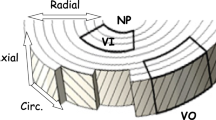Summary
The effects of axial traction stress on intradiscal hydration, solute transport and proteoglycan synthesis were examined in 658 porcine coccygeal intervertebral discs in vitro. Measurements were performed in three tissue fractions: nucleus pulposus, inner and outer annulus fibrosus. At 0.80 MPa traction stress, the equilibrium hydration did not change in the nucleus pulposus. However, in the inner and outer annulus, the equilibrium hydration was reduced, and the change led to an increase of the effective fixed charge density. Diffusion of solute to the nucleus pulposus was significantly suppressed at 0.80 MPa traction stress. The fluid flow of the intervertebral disc tended to be suppressed during the creep recovery process after compression. The proteoglycan synthesis rate in the outer annulus was markedly suppressed by traction stress of 0.80 MPa for 4 h, but not that in the nucleus pulposus. These results suggest that a prolonged excessive axial traction stress induces a decrease in tissue hydration in the annulus fibrosus, and this may lead to an increase in the fractional volume of solid in the matrix and tissue osmotic pressure, resulting in diffusion inhibition of solute and suppression of proteoglycan synthesis. Thus, prolonged and excessive spinal traction may accelerate disc degeneration.
Similar content being viewed by others
References
Adams MA, Hutton WC (1983) The effect of posture on the fluid content of lumbar intervertebral disc. Spine 8:665–671
Bayliss MT, Urban JPG, Johnstone B, Holm S (1986) In vitro method for measuring synthesis rates in the intervertebral discs. J Orthop Res 4:10–17
Bayliss MT, Johnstone B, O'Brien JP (1988) Proteoglycan synthesis in the human intervertebral disc. Variation with age, region and pathology. Spine 13:972–981
Burton CV (1988) Gravity lumbar reduction. In: Kirkaldy-Willis WH (ed) Managing low back pain, 2nd edn. Churchill Livingstone, New York, pp 305–314
Fart I, Goldstick K (1965) Dynamics of water transport in swelling membranes. J Colloid Sci 2:962–989
Gillard GC, Reilly HC, Bell-Booth PG, Flint MH (1979) The influence of mechanical forces on the glycosaminoglycan content of the rabbit flexor digitorum profundus tendon. Connect Tissue Res 7:37–46
Hirano N, Tsuji H, Ohshima H, Kitano S, Sano A (1988) Analysis of rabbit intervertebral disc physiology based on water metabolism. Part 1. Factors influencing metabolism of the normal intervertebral discs. Spine 13:1291–1296
Hirano N, Tsuji H, Ohshima H, Kitano S, Sano A (1988) Analysis of rabbit intervertebral disc physiology based on water metabolism. Part. 2. Changes in normal intervertebral discs under axial vibratory load. Spine 13:1297–1302
Ishihara H, Tsuji H, Hirano N, Ohshima H, Terahata N (1992) Effects of continuous quantitative vibration on rheologic and biological behaviors of the intervertebral disc. Spine 17:S7-S12
Kedem O, Katchalsky A (1958) Thermodynamic analysis of the permeability of biological membranes to non-electrolytes. Biochim Biophys Acta 27:229–245
Krämer J (1977) Pressure dependent fluit shift in the intervertebral disc. Orthop Clin North Am 8:211–216
Lanir Y, Salant EL, Foux A (1988) Physicochemical and microstructural changes in collagen fiber bundles following stretch in vitro. Biorheology 25:591–603
Markolf KL (1972) Deformation of thoracolumbar intervertebral joints in response to external loads. J Bone Joint Surg [Am] 54:511–533
Maroudas A (1980) Physical chemistry of articular cartilage and the intervertebral disc. In: Sokoloff L (ed) The joint and synovial fluid, vol II. Academic Press, New York, pp 239–291
Maroudas A, Bannon C (1981) Measurement of swelling pressure in cartilage and comparison with the osmotic pressure of constituent proteoglycans. Biorheology 18:619–632
Myers ER, Zhu W, Mow VC (1988) The material properties and the viscoclastic behavior of cartilage. In: Nimni ME (ed) Collagen. CRC Press, Barton Rouge, pp 271–288
Nachemson A, Elfström G (1970) Intravital dynamic pressure measurements in lumbar disc. A study of common movements, and exercises. Scand J Rehabil Med 2 (Suppl 1):1–40
Ohshima H, Tsuji H, Hirano N, Ishihara H, Katoh T, Yamada H (1989) Water diffusion pathway, swelling pressure, and biomechanical properties of the intervertebral disc during compression load. Spine 14:1234–1244
Roth V, Mow VC (1980) The intrinsic tensile behavior of the matrix of bovine articular cartilage and its variation with age. J Bone Joint Surg [Am] 62:1102–1117
Schneiderman R, Keret D, Maroudas A (1986) Effects of mechanical and osmotic pressure on the rate of glycosaminoglycan synthesis in human adult femoral head cartilage: an in vivo study. J Orthop Res 4:393–408
Twomey LT (1985) Sustained lumbar traction. Spine 10:146–149
Urban JPG, Maroudas A (1979) The measurement of fixed charge density in the intervertebral disc. Biochim Biophys Acta 586:166–178
Urban JPG, Holm SH, Maroudas A (1978) Diffusion of small solutes into the intervertebral disc: an in vivo study. Biorheology 15:203–223
Viidic A (1968) A rheological model for uncalcified parallelfibred collagenous tissue. J Biomech 1:3–11
Author information
Authors and Affiliations
Rights and permissions
About this article
Cite this article
Terahata, N., Ishihara, H., Ohshima, H. et al. Effects of axial traction stress on solute transport and proteoglycan synthesis in the porcine intervertebral disc in vitro. Eur Spine J 3, 325–330 (1994). https://doi.org/10.1007/BF02200145
Issue Date:
DOI: https://doi.org/10.1007/BF02200145




